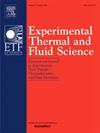旋翼集成加热系统对无人机飞行结冰防护效果的实验研究
IF 3.3
2区 工程技术
Q2 ENGINEERING, MECHANICAL
Experimental Thermal and Fluid Science
Pub Date : 2025-03-26
DOI:10.1016/j.expthermflusci.2025.111485
引用次数: 0
摘要
为评估旋翼集成加热系统(RIHS)对无人机(UAV)飞行结冰防护的有效性,进行了实验研究。RIHS由一个柔性电膜加热器组成,该加热器包裹在无人机旋翼模型的叶片周围,用于加热叶片表面以减少结冰。在爱荷华州立大学的结冰研究隧道(ISU-IRT)进行了实验研究,将旋翼模型暴露在无人机低空飞行所经历的各种典型结冰条件下。在实验过程中,采用锁相技术记录了激活的RIHS在旋翼叶片表面的防/除冰特性,并在结冰实验过程中测量了旋翼模型产生的气动力和无人机旋翼以预先选定的角速度旋转所需的电力,以量化采用RIHS对无人机飞行结冰的好处。虽然RIHS在确保转子模型在整个结冰实验期间产生几乎相同数量的气动力方面是有效的,但在glaze、混合和霜结冰条件下,RIHS去除/除去转子叶片上的冰所需要的最小功率密度分别为PD = 2.0、6.0和10.0 kW/m2。还证明,与不采取任何防/除冰措施的情况相比,激活RIHS的成功防/除冰可以导致无人机转子所需的功耗节省至少65%,63%和57%,分别产生所需的升力,以确保无人机在玻璃,混合和霜结冰条件下保持空中飞行。本文章由计算机程序翻译,如有差异,请以英文原文为准。
An experimental study to evaluate the effectiveness of a Rotor-Integrated-Heating system for UAV inflight icing protection
An experimental investigation was conducted to evaluate the effectiveness of a Rotor-Integrated Heating System (RIHS) for Uncrewed-Aerial-Vehicle (UAV) inflight icing protection. The RIHS is composed of a flexible electric film heater that is wrapped around the blades of a UAV rotor model to heat the blade surfaces for icing mitigation. The experimental study is conducted in the Icing Research Tunnel of Iowa State University (ISU-IRT) with the rotor model exposed to a variety of typical icing conditions experienced by UAVs flying in low-altitude airspace. During the experiments, while a phase-locked technique is employed to record the anti-/de-icing features over the surface of the rotor blade with the activated RIHS, the aerodynamic forces generated by the rotor model and the electric power required by the UAV rotor spinning at a pre-selected angular speed are also measured during the icing experiments to quantify the benefits of employing the RIHS for UAV inflight icing mitigation. While the RIHS is found to be effective in ensuring that the rotor model generates almost the same amount of aerodynamic forces over the entire duration of the icing experiments, the minimum power density required by the RIHS to remove/shed ice accretion from the rotor blade is found to be PD = 2.0, 6.0 and 10.0 kW/m2 under the glaze, mixed and rime icing conditions, respectively. It is also demonstrated that, in comparison to the scenario without taking any anti-/de-icing measures, the successful anti-/de-icing with the activated RIHS can lead to at least 65 %, 63 % and 57 % saving in the required power consumption for the UAV rotor generating required lifting forces to ensure the UAV stay airborne under the glaze, mixed and rime icing conditions, respectively.
求助全文
通过发布文献求助,成功后即可免费获取论文全文。
去求助
来源期刊

Experimental Thermal and Fluid Science
工程技术-工程:机械
CiteScore
6.70
自引率
3.10%
发文量
159
审稿时长
34 days
期刊介绍:
Experimental Thermal and Fluid Science provides a forum for research emphasizing experimental work that enhances fundamental understanding of heat transfer, thermodynamics, and fluid mechanics. In addition to the principal areas of research, the journal covers research results in related fields, including combined heat and mass transfer, flows with phase transition, micro- and nano-scale systems, multiphase flow, combustion, radiative transfer, porous media, cryogenics, turbulence, and novel experimental techniques.
 求助内容:
求助内容: 应助结果提醒方式:
应助结果提醒方式:


